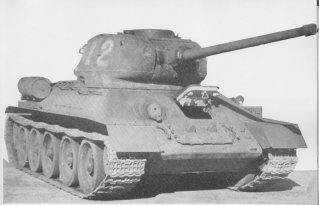Armor in World War II
The Soviet Union
In their studies between the wars, the Soviets apparently arrived
at much the same conclusions as the Germans. Marshal Tukhachevsky
developed the concept of "deep battle" -- the nearly simultaneous
assault of the entire depth of the enemy's defensive lines.
The Russians distinguished between three types of armored
formations and developed unique armored vehicles suitable to each
type of operation:
- NPP - Immediate Infantry Support;
- DPP - Long-range Infantry Support;
- DD - Long-range Forces.
DPP forces consisted of heavier tanks, with stronger armament necessary to break into and through defensive positions. Like the Germans, the Russians developed heavy assault guns and these vehicles were a major component of the DPP forces.
Once a breakthrough was achieved, the DD forces moved quickly forward to
 exploit the opportunity. DD tanks were somewhat lighter
than those of the DPP forces, and were designed for mobility and
long range. The T-34 pictured to the right was intended for the
DD forces and sported additional fuel tanks on its rear deck to
extend its operating range. The T-34 was the most successful of
Russian tanks and when fitted with the 85mm gun was rated by the
Germans as the best tank they faced in World War II.
exploit the opportunity. DD tanks were somewhat lighter
than those of the DPP forces, and were designed for mobility and
long range. The T-34 pictured to the right was intended for the
DD forces and sported additional fuel tanks on its rear deck to
extend its operating range. The T-34 was the most successful of
Russian tanks and when fitted with the 85mm gun was rated by the
Germans as the best tank they faced in World War II.
Well that was the theory, but in practice things worked a bit differently. It didn't help that Stalin purged most of the tank force commanders shortly before the Germans attacked leaving the work to untrained and inexperienced commanders. The debacle of 1941 was the inevitable result.
Following the stunning German victories in the opening stages of the war, the Soviets reorganized. Their acute shortage of trained and experienced leaders forced them into a higher degree of specialization than any other army. This specialization resulted in the creation of largely single-purpose military formations.
A rifle division was just that. It had no tanks, and little if any organic artillery. Likewise, a tank army was a tank army with little associated infantry. The Soviets even fielded specialists in night fighting. Massing their artillery in divisions and corps, the soviets opened up their attacks with bombardments reminiscent of the western front in World War I.
When the attack finally came it was conducted by specialist units across fronts of many miles. When a breakthrough was achieved, exploitation was hampered by Stalin's insistence that orders were to be carried out exactly as written. Consequently, Soviet attackers relentlessly pursued their initial objectives completely ignoring opportunities to make spectacular gains. Soviet attacks ran straight forward until they petered out from exhaustion.
Time and again in 1942, but with decreasing frequency from then on, the Germans were able to cut off the base of a Russian salient, seal the breach in their defensive positions and bag large numbers of prisoners and equipment. Still the Soviets continued their massive straight ahead assaults because they had no choice. They lacked both leadership and tactical freedom to do anything else.
Eventually, the relentless Soviet attacks wore the Germans so thin that they were unable to effectively resist and eastern front began to crumble. This was not so much a tribute to superior Soviet tactics as it was a tribute to superior Soviet production and a willingness to sacrifice large numbers of soldiers to achieve victory.
Page Last Updated 04/30/99
This page has been visited times
since April, 30, 1999.